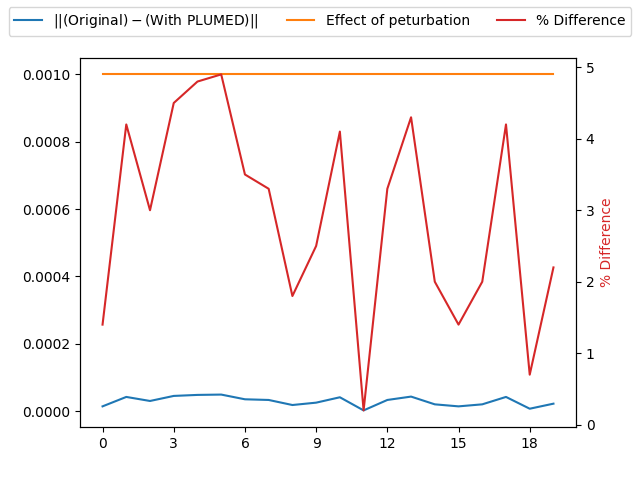Checking PLUMED can add a restraint
To check that the forces are being correctly passed from PLUMED to the MD code we test that the result from a PLUMED calculation where the following plumed input is used produces results that are equivalent to the result that is obtained when the restraint is applied within the MD code.
dd: DISTANCECalculate the distance/s between pairs of atoms. More details ATOMSthe pair of atom that we are calculating the distance between=1,2 RESTRAINTAdds harmonic and/or linear restraints on one or more variables. More details ARGthe values the harmonic restraint acts upon=dd KAPPA specifies that the restraint is harmonic and what the values of the force constants on each of the variables are=2000 ATthe position of the restraint=0.6 PRINTPrint quantities to a file. More details ARGthe labels of the values that you would like to print to the file=dd FILEthe name of the file on which to output these quantities=plumed_restraint
To check that the two ways of applying the restraint are equivalent we use the following PLUMED input for the calculation where the MD code applies the restraint:
dd: DISTANCECalculate the distance/s between pairs of atoms. More details ATOMSthe pair of atom that we are calculating the distance between=1,2 PRINTPrint quantities to a file. More details ARGthe labels of the values that you would like to print to the file=dd FILEthe name of the file on which to output these quantities=mdcode_restraint
Trajectories
-
Input and output files for the calculation where the restraint is applied by the MD code available in this zip archive
-
Input and output files for the calculation where the restraint is applied by PLUMED are available in this [zip archive](forces2_master.zip
Results
| Original | With PLUMED | Effect of peturbation | % Difference |
|---|---|---|---|
| 1.1976 | 1.197586 | 0.001 | 1.399999999995849 |
| 1.2069 | 1.206942 | 0.001 | 4.199999999987547 |
| 1.2143 | 1.21433 | 0.001 | 2.999999999997449 |
| 1.2203 | 1.220255 | 0.001 | 4.4999999999850715 |
| 1.2253 | 1.225348 | 0.001 | 4.8000000000048 |
| 1.2275 | 1.227451 | 0.001 | 4.899999999996574 |
| 1.2262 | 1.226235 | 0.001 | 3.5000000000007248 |
| 1.2215 | 1.221467 | 0.001 | 3.2999999999949736 |
| 1.214 | 1.213982 | 0.001 | 1.8000000000073513 |
| 1.2042 | 1.204175 | 0.001 | 2.4999999999941735 |
| 1.1942 | 1.194159 | 0.001 | 4.099999999995774 |
| 1.1836 | 1.183602 | 0.001 | 0.20000000000575113 |
| 1.1745 | 1.174533 | 0.001 | 3.2999999999949736 |
| 1.1677 | 1.167743 | 0.001 | 4.300000000001525 |
| 1.1649 | 1.16488 | 0.001 | 2.0000000000131024 |
| 1.1652 | 1.165186 | 0.001 | 1.399999999995849 |
| 1.1686 | 1.16862 | 0.001 | 1.999999999990898 |
| 1.1762 | 1.176242 | 0.001 | 4.2000000000097515 |
| 1.186 | 1.185993 | 0.001 | 0.6999999999868223 |
| 1.1976 | 1.197622 | 0.001 | 2.199999999996649 |
The table below includes some of the results from the calculation. The columns contain:
- The time series of distance values that were obtained when the restraint was applied by the MD code, $x_{md}$.
- The time series of distance values that were obtained when the restraint was applied by PLUMED, $x_{pl}$.
- The tolerances that were used when comparing these quantities, $\delta$.
- The values of $100\frac{\vert x_{md} - x_{pl}\vert }{ \delta}$.
If the PLUMED interface is working correctly the first two sets of numbers should be identical and the final column should be filled with zeros.
Graphical representation (beta)
A visualization of the table above:



